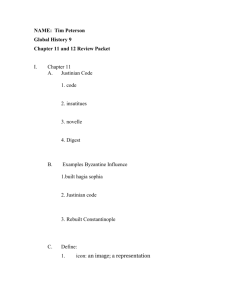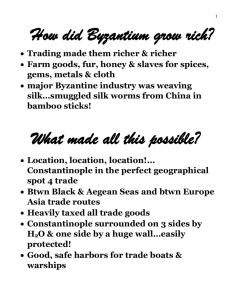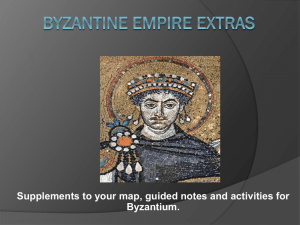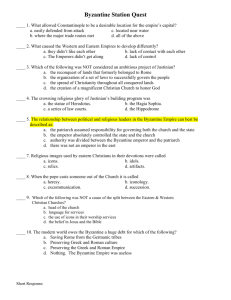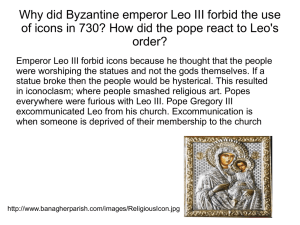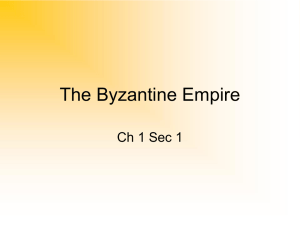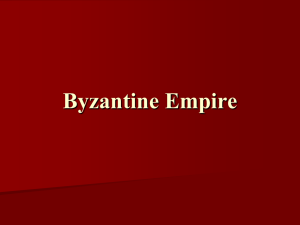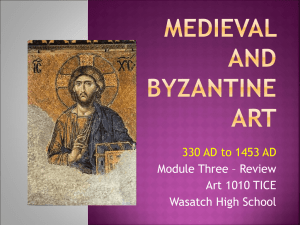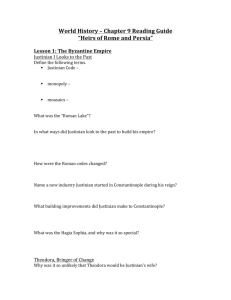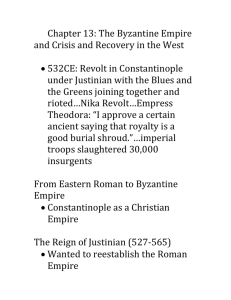Inside the Byzantine Empire TCI 7.2.1ppt
advertisement
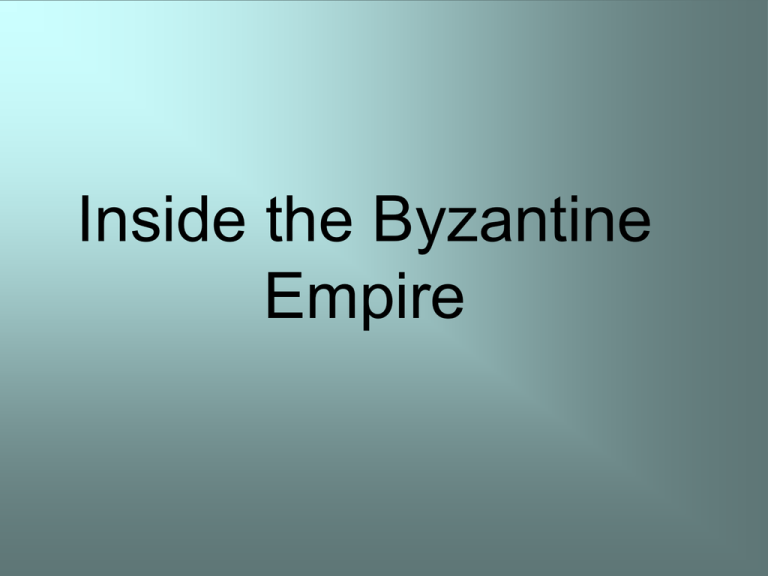
Inside the Byzantine Empire Where is the location? What buildings stand out? Why? How could this city be protected from invaders? Byzantine Empire: 330 CE – 1453 CE • Surrounded on three sides by water; good for trade and defense • Control of Bosporus Strait made the city a shipping and trading hub • Capital of Eastern Roman Empire; heavily influenced by Roman culture • Just like Rome, built on seven hills and divided into 14 districts •Protected by 13 miles of walls, watchtowers, and gates •walls only needed to be built on one side of the city •survived centuries of riots, religious discord, wars, and 88 leaders •seized by Turks in 1453 and renamed Istanbul; today it is a major city in modern Turkey Which person stands out in this picture? Describe him. Describe clothing and objects they are holding. Who do you think they are? How Justinian was Described While alive: devout, determined, and energetic After death: Procopius referred to him as two-faced and cruel What Justinian Accomplished • Legal Codes • Came to throne at age 45; considered most ambitious ruler Acted as head of church and • state Drove barbarians out of North Africa Spain and Italy Expanded Byzantine Empire but failed to capture Rome Built bridges, churches, hospitals, libraries, parks His scholars revised laws and created Corpus Juris Civilis This code of Justinian influenced many Western legal codes Which person stands out? Describe her Who might she be? How is this mosaic different from the previous one? Theodora sometimes angers Justinian by giving orders that cancel his orders. I wouldn’t get on Theodora’s bad side because she destroys her enemies. Justinian should not flee the Empire. He should crush the Nika rebels. Theodora has helped all women by convincing her husband to expand women’s rights. The poor and homeless should thank Theodora because she has started programs to help them. THEODORA •Born into lower class as daughter of bear-keeper •As a teenager worked as an actress and dancer •Loved adventure, new friendships, and travel •Married Justinian while in her 20’s and settled down •Equaled and sometimes surpassed Justinian in political skill and wisdom •Convinced her husband to crush Nika Rebellion Describe interior of this building. What shapes do you see? What do you think took longest to build? •Key points in the History of the Hagia Sophia built during reign of Justinian; largest of Justinian’s 25 new cathedrals built in 5 years (A.D. 532-A.D. 537) and is also known as Church of Holy Wisdom When Constantinople fell to the Turks, Hagia Sophia became a mosque today it is a museum • • • Height= 180 feet diameter= 107 feet Dome contains 40 stained-glass windows at its circumference Six colors of marble were used building the walls, arches, and columns This is a pendentive; it joins the wall with the base of the dome Mosaics (pictures made of pieces of colored glass or stone inlaid in plaster) glittered in the daytime Important Concepts Found in Hagia Sophia’s Architecture •Plain exterior symbolized earthly life •Ornate interior symbolizes spiritual universe •Cathedral’s size, thick pillars, and enclosed space show Roman influence •Intricate and ornate design show Eastern influences Who is depicted here? Why do you think some people paint pictures of religious figures or events? •Icons • In the West icons were to be respected •Icons are pictures of important Christians or sacred events. They take the form of murals, mosaics, or wooden panels. •In the East icons were used, although many disapproved of them •How the Great Schism Happened •Catholic Church •Catholic is Latin for “universal” •Masses conducted in Latin •Pope thought to be supreme religious authority •Clergy was celibate •1. Christians in the Holy Roman Empire used icons because few people could read •2. Some Christians in the Byzantine Empire disapproved of showing devotion to icons •3. The controversy over icons raged for years, it was one of many conflicts between the Church in the east and the west. •4. In 1054 A.D. the Christian church split into two churches forever. •Orthodox Church •Orthodox is Greek for “correct belief” •Masses conducted in Greek; Bible translated into various languages •Patriarch appointed by Byzantine emperor •Bishops celibate; priests could marry Where is Constantinople? What do the lines represent? If you got on a camel or horse, where could you go? If you boarded a ship, where could you go? Why is Constantinople in a good location to be the capital of a military and trading Empire? Lands and Trading Routes of the Byzantine Empire England Export: iron and tin Import: works of the ancient Greeks Russia Export: honey, wood, and furs Import: art, architecture, and Christianity France Export: fine wines and wool Import: silk (after stealing process from Chinese) Spain Export: cork and grain Import: bronze church doors China Export: silk Import: Christianity and gold Africa Export: ivory and gold Import: silk (after stealing processes from Chinese) India Export: spice, pepper, and jewels Import: ivory

